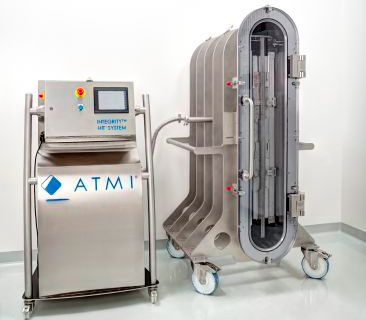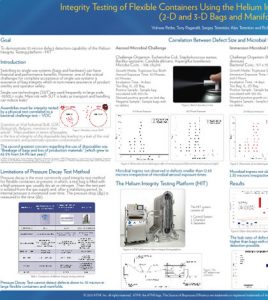
Ensuring Integrity and Sterility of Single-Use Assemblies
A Guest Blog by Alex Terentiev, Ph.D., R&D and Engineering Director, ATMI &
Vishwas Pethe, R&D Scientist, ATMI
The Benefits of Single-Use Systems
Single-use technologies have made a huge impact in biopharmaceutical production. The benefits of single-use systems are clearly validated by the speed with which they have been accepted and incorporated into biopharmaceutical manufacturing. Single-use technologies represent not just bio-processing bags, but also an increasing number of components and complex bag assemblies like manifolds. Single-use systems provide solutions for many phases of biopharmaceutical manufacturing.
In upstream processes single-use mixers, storage bags and filters are used for cell culture media, which can then be transferred into single-use bioreactors for product manufacturing. In downstream processing, single-use mixing, filtration and chromatography components support several processes including viral clearance, storage, and formulation/fill.
Key Advantages of Single-Use Technologies
- Operational flexibility
- Reduced process turnaround time
- Increased safety in product change over
- Speed and ease of use
- Cost savings
- Elimination of cleaning operations and associated validation
Ensuring Integrity and Sterility
While single-use systems have many clear advantages, one challenge is ensuring the integrity of these plastic bags and components. Microscopic breaches of integrity, even those that cannot be seen, can allow microbial ingress. Possible breaches extend beyond just the bags, so the entire single-use assembly including tubing, connectors, seals, etc. must be tested for integrity to ensure against potential contamination problems.
Bacterial contamination can result in significant losses for the companies involved. Firstly, there is the actual product loss that comes from a contamination failure, but beyond that there is the loss of time and money to clean and validate after a contamination. Companies also frequently incur increased scrutiny from regulators and in the worst-case scenario you can have product safety issues, loss of public confidence and a drop in company value. During cytotoxic transfer, operator risk is also a major concern. With so much at stake, ensuring integrity of single use assemblies is paramount.
Articles Testing Method
To address integrity concerns, companies that manufacture single-use components will typically conduct a visual inspection and perform pressure decay testing. Pressure decay testing is the industry standard for validating single-use bag integrity, however there are limitations1 to the level of assurance this testing can provide.
Pressure decay testing measures a drop in pressure within a bag body to determine the existence of a leak. This type of test method is limited in scope to stand-alone bag compartments and can be inhibited if the bag compartment is connected to tubing and other single-use components. The sensitivity of a pressure decay test has been demonstrated to be a 50-micron defect size for 50L bags and 100 micron for 200L bags. The cycle time for such a test could range from 10 minutes to upwards of 45-60 minutes, depending on the equipment used and bag compartment size. Bag manufacturers commonly apply pressure decay testing to ensure product quality just prior to shipment of the bag.
Even though the product is tested at the point of manufacture, there is no guarantee that the components are still intact by the time they reach point of use. Shipping of these items can create possible breaches. After product leaves manufacturer, there are many potentially hazardous scenarios – shipping damage, Gamma irradiation and temperature extremes can all compromise the integrity of plastic single-use bags and fittings.
HIT™ (Helium Integrity Testing) System Addresses Unmet Need
ATMI’s HIT™ system addresses both the challenge of testing complete single-use assemblies and ensuring bag integrity at point-of-use. The system was first launched in 2010 as an in-house add-on testing service for the company’s 2-D bioprocess bags and manifolds, and now the HIT system has evolved to the next level. It is offered in multiple formats: either as add-on testing for the full line of ATMI 2-D and 3-D vessels up to 200L, or as a point-of-use-system to customers for implementation in their own facilities.
The HIT™ System uses a control unit that houses highly sensitive mass spectrometry equipment, and a test chamber with a fully customizable containment rack. The single- use assembly to be tested is put into the test chamber and connected to service hoses, and then the test chamber is evacuated. During chamber evacuation, the test unit is pressurized with the helium gas. After a stabilization time, the detector is linked to the vacuum line to detect the helium gas flow through a leak. The full test cycle time averages 10 minutes, depending on the bag or compartment size.
HIT™ detects defects as small as 10-micron. Based on third-party validation studies, 12-micron defects were found to be the threshold of microbial ingress in rigorous Log-6 aerosol challenges. This breakthrough technology can also be used for both bag and tubing assemblies with multiple single-use components.
Key Advantages of HIT
- Tests fully assembled bags and manifolds, not just bag compartments
- Ensures integrity at point of use, just prior to using.
- Detects defects down to 10-micron level, which is below the microbial ingress threshold found in aerosol challenge testing.
- Test cycle time for POU-HIT is much shorter when compared to typical pressure decay times.
The HIT™ system enables state of the art integrity testing of single-use assemblies at the vendor facility and the option of testing at point-of-use for customers who want to ensure integrity defined by microbiological challenge ingress, prior to use.
Footnotes
-
1. Pethe, V.; Terentiev, A.; Et Al, “Helium Integrity Testing”, Pharmaceutical Processing, September Issue, pp. 22-24 (2011)
